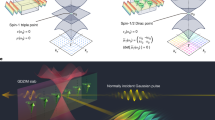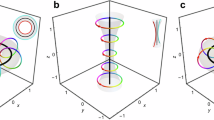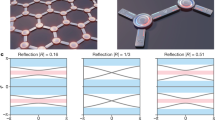Abstract
Topological defects and disorder counteract each other1,2,3,4,5. Intuitively, disorder is considered detrimental, requiring efforts to mitigate its effects in conventional topological photonics6,7,8,9. We propose a counter-intuitive approach that exploits a real–momentum topological photonic crystal that harnesses real-space disorder to generate a Pancharatnam–Berry phase10,11, without disrupting the momentum-space singularity originating from bound states in the continuum12. This methodology allows flat optical devices to encode spatial information or even extra topological charge in real space while preserving the topology of bound states in the continuum in momentum space with inherent alignment. Here, as a proof of concept, we demonstrate the simultaneous and independent generation of a real-space broadband vortex or a holographic image alongside resonant momentum-space vortex beams with a narrow bandwidth, which cannot be achieved with conventional methods. Such engineered disorder contributes to vast intrinsic freedoms without adding extra dimensions or compromising the optical flatness13,14. Our findings of real–momentum duality not only lay the foundation for disorder engineering in topological photonics but also open new avenues for optical wavefront shaping, encryption and communications.
This is a preview of subscription content, access via your institution
Access options
Access Nature and 54 other Nature Portfolio journals
Get Nature+, our best-value online-access subscription
$32.99 / 30 days
cancel any time
Subscribe to this journal
Receive 51 print issues and online access
$199.00 per year
only $3.90 per issue
Buy this article
- Purchase on SpringerLink
- Instant access to full article PDF
Prices may be subject to local taxes which are calculated during checkout





Similar content being viewed by others
Data availability
The data supporting the findings of this study are available in the article and the Supplementary Information.
References
Jin, J. et al. Topologically enabled ultrahigh-Q guided resonances robust to out-of-plane scattering. Nature 574, 501–504 (2019).
Liu, C., Zhang, S., Maier, S. A. & Ren, H. Disorder-induced topological state transition in the optical skyrmion family. Phys. Rev. Lett. 129, 267401 (2022).
Lin, Z.-K. et al. Topological phenomena at defects in acoustic, photonic and solid-state lattices. Nat. Rev. Phys. 5, 483–495 (2023).
Ozawa, T. et al. Topological photonics. Rev. Mod. Phys. 91, 015006 (2019).
Mermin, N. D. The topological theory of defects in ordered media. Rev. Mod. Phys. 51, 591–648 (1979).
Lu, L., Joannopoulos, J. D. & Soljačić, M. Topological photonics. Nat. Photon. 8, 821–829 (2014).
Yu, S., Qiu, C.-W., Chong, Y., Torquato, S. & Park, N. Engineered disorder in photonics. Nat. Rev. Mater. 6, 226–243 (2021).
Shapiro, J. & Tauber, C. Strongly disordered Floquet topological systems. Ann. Henri Poincaré 20, 1837–1875 (2019).
Zhang, Z., Delplace, P. & Fleury, R. Superior robustness of anomalous non-reciprocal topological edge states. Nature 598, 293–297 (2021).
Lin, D., Fan, P., Hasman, E. & Brongersma, M. L. Dielectric gradient metasurface optical elements. Science 345, 298–302 (2014).
Song, Q. et al. Ptychography retrieval of fully polarized holograms from geometric-phase metasurfaces. Nat. Commun. 11, 2651 (2020).
Wang, B. et al. Generating optical vortex beams by momentum-space polarization vortices centred at bound states in the continuum. Nat. Photon. 14, 623–628 (2020).
Dorrah, A. H. & Capasso, F. Tunable structured light with flat optics. Science 376, eabi6860 (2022).
Chen, W. T., Zhu, A. Y. & Capasso, F. Flat optics with dispersion-engineered metasurfaces. Nat. Rev. Mater. 5, 604–620 (2020).
Khanikaev, A. B. & Alù, A. Topological photonics: robustness and beyond. Nat. Commun. 15, 931 (2024).
He, L. et al. Floquet Chern insulators of light. Nat. Commun. 10, 4194 (2019).
Biesenthal, T. et al. Fractal photonic topological insulators. Science 376, 1114–1119 (2022).
Pyrialakos, G. G. et al. Bimorphic Floquet topological insulators. Nat. Mater. 21, 634–639 (2022).
Dutt, A., Minkov, M., Williamson, I. A. D. & Fan, S. Higher-order topological insulators in synthetic dimensions. Light: Sci. Appl. 9, 131 (2020).
Kruk, S. et al. Nonlinear light generation in topological nanostructures. Nat. Nanotechnol. 14, 126–130 (2019).
Hwang, M.-S. et al. Vortex nanolaser based on a photonic disclination cavity. Nat. Photon. 18, 286–293 (2024).
Wang, Y. et al. Hybrid topological photonic crystals. Nat. Commun. 14, 4457 (2023).
Kim, M., Jacob, Z. & Rho, J. Recent advances in 2D, 3D and higher-order topological photonics. Light: Sci. Appl. 9, 130 (2020).
Song, Q., Odeh, M., Zúñiga-Pérez, J., Kanté, B. & Genevet, P. Plasmonic topological metasurface by encircling an exceptional point. Science 373, 1133–1137 (2021).
You, J. W. et al. Topological metasurface: from passive toward active and beyond. Photonics Res. 11, B65–B102 (2023).
Joannopoulos, J. D., Johnson, S. G., Winn, J. N. & Meade, R. D. Photonic Crystals: Molding the Flow of Light (Princeton Univ. Press, 2008).
Chen, Z. & Segev, M. Highlighting photonics: looking into the next decade. eLight 1, 2 (2021).
Hsu, C. W., Zhen, B., Stone, A. D., Joannopoulos, J. D. & Soljačić, M. Bound states in the continuum. Nat. Rev. Mater. 1, 16048 (2016).
Zhen, B., Hsu, C. W., Lu, L., Stone, A. D. & Soljačić, M. Topological nature of optical bound states in the continuum. Phys. Rev. Lett. 113, 257401 (2014).
Koshelev, K., Bogdanov, A. & Kivshar, Y. Meta-optics and bound states in the continuum. Sci. Bull. 64, 836–842 (2019).
Wang, J. et al. Optical bound states in the continuum in periodic structures: mechanisms, effects, and applications. Photonics Insights 3, R01 (2024).
Qin, H. et al. Arbitrarily polarized bound states in the continuum with twisted photonic crystal slabs. Light: Sci. Appl. 12, 66 (2023).
Kodigala, A. et al. Lasing action from photonic bound states in continuum. Nature 541, 196–199 (2017).
Huang, C. et al. Ultrafast control of vortex microlasers. Science 367, 1018–1021 (2020).
Zhai, Z. et al. Multimode vortex lasing from dye–TiO2 lattices via bound states in the continuum. ACS Photonics 10, 437–446 (2023).
Chen, Y. et al. Compact spin-valley-locked perovskite emission. Nat. Mater. 22, 1065–1070 (2023).
Wang, Z., Chong, Y., Joannopoulos, J. D. & Soljačić, M. Observation of unidirectional backscattering-immune topological electromagnetic states. Nature 461, 772–775 (2009).
Bahari, B. et al. Nonreciprocal lasing in topological cavities of arbitrary geometries. Science 358, 636–640 (2017).
Ye, W., Gao, Y. & Liu, J. Singular points of polarizations in the momentum space of photonic crystal slabs. Phys. Rev. Lett. 124, 153904 (2020).
Koshelev, K., Lepeshov, S., Liu, M., Bogdanov, A. & Kivshar, Y. Asymmetric metasurfaces with high-Q resonances governed by bound states in the continuum. Phys. Rev. Lett. 121, 193903 (2018).
Liu, W. et al. Circularly polarized states spawning from bound states in the continuum. Phys. Rev. Lett. 123, 116104 (2019).
Cohen, E. et al. Geometric phase from Aharonov–Bohm to Pancharatnam–Berry and beyond. Nat. Rev. Phys. 1, 437–449 (2019).
Song, Q., Liu, X., Qiu, C.-W. & Genevet, P. Vectorial metasurface holography. Appl. Phys. Rev. 9, 011311 (2022).
Yang, Z. et al. Asymmetric full-color vectorial meta-holograms empowered by pairs of exceptional points. Nano Lett. 24, 844–851 (2024).
Yu, Z. et al. A spatial-frequency patching metasurface enabling super-capacity perfect vector vortex beams. eLight 4, 21 (2024).
Lv, W. et al. Robust generation of intrinsic C points with magneto-optical bound states in the continuum. Sci. Adv. 10, eads0157 (2024).
Huang, S. H. et al. Microcavity-assisted multi-resonant metasurfaces enabling versatile wavefront engineering. Nat. Commun. 15, 9658 (2024).
Yu, Z. et al. High-security learning-based optical encryption assisted by disordered metasurface. Nat. Commun. 15, 2607 (2024).
Zhang, Z., Wang, J., Qin, H. & Fleury, R. Floquet topological physics in photonics. Preprint at https://doi.org/10.1364/opticaopen.27930081.v1 (2024).
Gahagan, K. T. & Swartzlander, G. A. Optical vortex trapping of particles. Opt. Lett. 21, 827–829 (1996).
Acknowledgements
Q.S. acknowledges funding support from the National Natural Science Foundation of China (grant nos. 12474388 and 12204264) and the Shenzhen Science and Technology Innovation Commission (grant no. JCYJ20230807111706014). This work is also funded by the Basic Research Program of Jiangsu (grant no. BK20243029). H.Q., Z.Z. and R.F. acknowledge funding support from the Swiss State Secretariat for Education, Research and Innovation (contract no. MB22.00028). C.-W.Q. acknowledges support from the Ministry of Education in Singapore (grant nos. A-8002152-00-00 and A-8002458-00-00) and a Competitive Research Program Award from the NRF, Prime Minister’s Office, Singapore (grant nos. NRF-CRP22-2019-0006 and NRF-CRP26-2021-0004). H.Q. and Z.S. thank H. Yang for help with instrumentation.
Author information
Authors and Affiliations
Contributions
H.Q., R.F. and Q.S. conceived the project. H.Q. carried out the numerical simulations. H.Q. and Z.S. fabricated the samples and conducted the measurements. H.Q., Z.Z., Z.S. and W.L. analysed the results and performed the visualizations. Z.Y., W.C., X.G. and H.W. provided technical support. H.Q., Z.Z., W.L. and Q.S. wrote the manuscript. H.Q., Z.Y., W.C., R.F., C.-W.Q., Y.S., B.L., J.Z. and Q.S. revised the manuscript. R.F., C.-W.Q. and Q.S. supervised the entire project. All authors discussed the results and commented on the article.
Corresponding authors
Ethics declarations
Competing interests
The authors declare no competing interests.
Peer review
Peer review information
Nature thanks Alex Krasnok, Gianluca Ruffato and Lei Shi for their contribution to the peer review of this work.
Additional information
Publisher’s note Springer Nature remains neutral with regard to jurisdictional claims in published maps and institutional affiliations.
Supplementary information
Supplementary Information
This file contains Supplementary Figs. 1–29 and Notes 1–8.
Supplementary Video 1
Wavelength-engineered real–momentum topology duality.
Rights and permissions
Springer Nature or its licensor (e.g. a society or other partner) holds exclusive rights to this article under a publishing agreement with the author(s) or other rightsholder(s); author self-archiving of the accepted manuscript version of this article is solely governed by the terms of such publishing agreement and applicable law.
About this article
Cite this article
Qin, H., Su, Z., Zhang, Z. et al. Disorder-assisted real–momentum topological photonic crystal. Nature 639, 602–608 (2025). https://doi.org/10.1038/s41586-025-08632-9
Received:
Accepted:
Published:
Issue date:
DOI: https://doi.org/10.1038/s41586-025-08632-9
This article is cited by
-
Electric-Field-Driven Generative Nanoimprinting for Tilted Metasurface Nanostructures
Nano-Micro Letters (2026)
-
Topological hysteretic winding for temporal anti-lasing
Nature Communications (2025)



